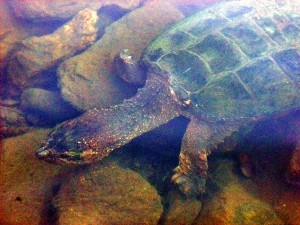Largemouth bass, northern pike, rainbow smelt, black crappie … no, someone did not just hand you a Maine restaurant menu for your fish dinner choices.
Illegal game fish introduced into Maine’s waterways is serious stuff. I was taking my youngest son’s black cocker spaniel Nicky for a walk early this morning and down by the Meduxnekeag River boat landing I saw the warning sign.

Like a wanted poster stapled up out west in the days of sleeping under the stars, eating canned beans, slurping coffee listening to coyotes. Propped up against your Western saddle next to your bed roll digging out the harmonica or knife to whittle. The river side sign shares news about up to $10,000 fines, $2000 reward checks being written to convictions of any one introducing illegal Maine game fish into our state’s precious waterways.
Here’s what the Inland, Fisheries people point out is the public enemy hit list for some of the fish that wreck the natural habitat on Maine’s waterfront.
Largemouth bass – If a waterbody already contains smallmouth bass, largemouth bass commonly outcompete smallmouths reducing their overall abundance. If a trout stocking program is active in a waterbody that largemouth bass become established in, the bass prey upon the stocked trout. This decreases angler catch rates for trout and may prompt MDIFW biologists to stop stocking trout altogether if predation rates on stocked trout become unacceptably high. Introduced largemouth bass have also decimated Maine baitfish populations in many waters, eliminating excellent opportunities to harvest baitfish, both recreationally and commercially.
Northern pike – Pike introductions create a significant change to the fish population structure within a waterbody. They will prey upon any available forage species (smelt, shiners, fallfish, and perch) as well as game fish (bass, pickerel, and both wild and stocked trout and salmon species). This reduces the overall abundance of both forage and game fish, which has drastic impacts to anglers over time. Protect our Maine waterways or lose them is the sobering choice to make.
Muskellunge – Muskies negatively impact wild brook trout populations in Maine. Due to their preference for cool-water habitat muskie actively prey upon native minnow species and brook trout. They also at the same time crowd out brook trout and slow down water habitat balance cycle. This reduces the overall abundance of brook trout in ponds and rivers where muskie are present. This impacts greatly the angler catch rates of trout over time. The reduction hurts our tourism economy, the local enjoyment of wetting the lines and casting for fish a long time Maine tradition.

Black crappie – Black crappie compete for forage with existing fish species when introduced to a waterbody. Due to their fast growth rates and high productivity, crappie can quickly become abundant. A unique life history trait exhibited by crappie is large-scale downstream movement of young-of-year fish. This allows for quick colonization of downstream waters.
Smallmouth bass – When smallmouth bass are introduced into waters with wild brook trout populations they prey upon the brook trout and compete with trout for food and available habitat. As the bass population becomes more abundant they will reduce or extirpate brook trout and spread into accessible waters upstream or downstream.
Landlocked alewife – Landlocked alewives compete with smelt populations, often reducing the abundance of smelt in a waterbody. This change produces a profound negative impact to landlocked salmon because smelt are the primary forage for salmon. Reduced smelt abundance decreases salmon growth and abundance, along with angler satisfaction.
Rainbow smelt – Smelt are common in many waters and are native to Maine. Though often used for bait, their introduction into wild brook trout ponds and small-sized Arctic charr waters cause significant negative impacts to trout and charr because adult smelt prey on the young of both species.
Leaving the natural resource to your kids in better shape than you found it is good stewardship. It is respect and consideration for the fish that need protection from anglers. And further education to show how the problem impacts the natural habitat.
But protection of the Maine waterways means we all have a role and should be concerned whether an angler or not. If fish could talk, the natives would gurgle lots. About watersheds and timber cutting operations miles away messing up the inlets to their homes. Lake loons, turtle, otters and all the other waterway animals would add to the chorus of what threatens their healthy way of life.

When a non-native or invasive species is illegally introduced into a Maine waterbody the following serious impacts can occur:
- Prey upon existing fish species in that Maine waterbody.
- Compete with existing Maine fish species for food and habitat.
- Spread to other Maine waterbodies (upstream and downstream) that are connected to the original water. This expands the range of the new species and continues impacting other existing fish populations.
- Increase the potential for fish diseases to be spread and for the introduction of new diseases from outside of Maine.
- Existing Maine regulations on the importation of live fish and health screening requirements for authorized transfers have prevented the spread of most fish diseases into Maine from neighboring states.
- Once an introduced fish species becomes established in a waterbody the fish community is changed forever. Education awareness is the key to give everyone a head’s up on what is threatening Maine’s waterfront.
We have blogged on milfoil before too which is not a pretty development in our Maine lakes and ponds.
Brought in by unclean props, float planes, etc, milfoil education has been on going and public funds are available to hire people to help the volunteer lake association members. To hand out brochures, connect with anglers and boaters. To monitor boat landings around Maine and increase awareness on how serious milfoil vegetative infestation really is to our heritage of clean fresh waterways. Before it takes over the waterfront and the remedies get tougher to correct and reverse the negative impact to the species of fish and other wildlife that call our lakes, ponds, rivers and streams home in Maine.
I’m Maine REALTOR Andrew Mooers, ME Broker
207.532.6573 | info@mooersrealty.com |
MOOERS REALTY 69 North Street Houlton Maine 04730 USA
